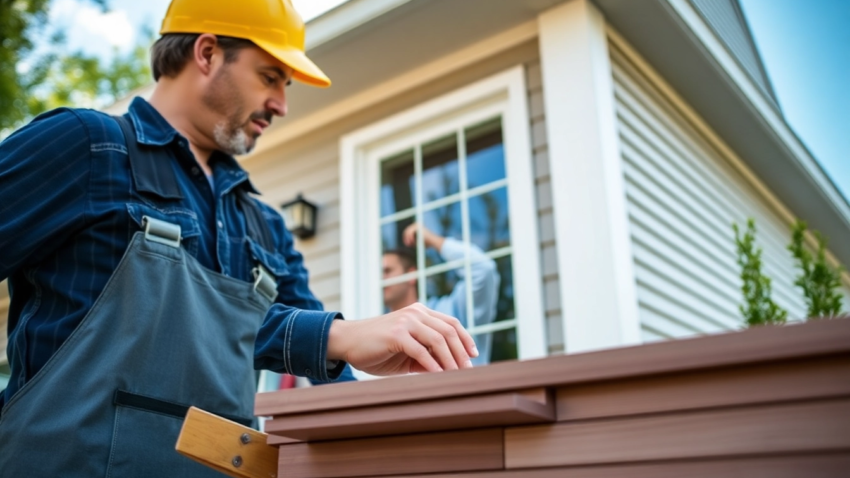
Professional Siding Contractor Tips to Improve Your Home’s Exterior Efficiency and Curb Appeal
Understanding the Role of a Siding Contractor
When it comes to enhancing your home’s exterior, few improvements can match the transformative impact of professional siding installation. A siding contractor plays a critical role in not only elevating your property’s aesthetic appeal but also ensuring the durability, energy efficiency, and maintenance of your outdoor surfaces. Choosing the right siding contractor is fundamental to achieving long-lasting results that align with your home improvement goals.
Siding contractors are specialized professionals responsible for installing, repairing, and replacing various types of exterior cladding materials. Their expertise encompasses a deep understanding of different siding options, proper installation techniques, local building codes, and weather considerations, all important for optimal performance and longevity. Whether you are seeking a modern vinyl facade or a classic cedar look, a skilled siding contractor ensures your vision comes to life with precision.
What Services Do Siding Contractors Offer?
The scope of services provided by siding contractors goes well beyond simple installation. These professionals offer a comprehensive range of solutions designed to maintain and upgrade your home’s exterior. Among their core services are:
- Siding installation: Expertly installing new siding on homes, commercial buildings, and renovations for improved appearance and protection.
- Siding replacement: Removing outdated or damaged siding and replacing it with modern, durable options.
- Siding repair: Addressing issues such as cracks, warping, or moisture intrusion before they escalate into major damage.
- Inspection and assessment: Evaluating the current condition of your siding and advising on the most suitable repair or upgrade strategies.
- Color and design consultation: Assisting homeowners with selecting siding styles, colors, and textures to complement architectural aesthetics.
- Inspection for underlying issues: Identifying and addressing structural problems, moisture infiltration, or insulation gaps that could compromise siding effectiveness.
Partnering with a reputable siding contractor ensures that these services are performed efficiently, safely, and in accordance with industry standards, ultimately safeguarding your investment and enhancing curb appeal.
Qualities to Look for in a Reliable Siding Contractor
Selecting a trustworthy siding contractor requires diligent assessment. The most reliable professionals exhibit the following qualities:
- Licensing and certifications: Valid licenses and industry certifications such as James Hardie Elite Preferred Contractor status attest to their expertise and adherence to regulations.
- Experience and reputation: Proven track records, positive customer reviews, and a portfolio of completed projects indicate reliability and skill.
- Comprehensive warranty: Offering warranties on both materials and workmanship demonstrates confidence in their services and provides peace of mind.
- Transparency in estimates: Clear, detailed quotes that outline costs, scope, and timelines prevent surprises and foster trust.
- Strong references and reviews: Talking to previous clients or reading online reviews can provide insights into their professionalism and quality of work.
- Local expertise: Contractors familiar with regional climate conditions and building codes are better equipped to deliver resilient siding solutions.
- Construction safety practices: A commitment to safety protocols protects both workers and homeowners during project execution.
Common Siding Materials Managed by Contractors
Siding material choice greatly influences the overall cost, durability, and aesthetic of your home. Here are some of the most popular siding options handled by contractors:
- Vinyl Siding: Known for affordability, ease of maintenance, and versatility, vinyl siding remains a top choice for many homeowners.
- Fiber Cement (Hardie Board): Renowned for its strength, fire resistance, and ability to mimic wood or masonry, fiber cement siding is ideal for durability and aesthetic flexibility.
- Cedar Siding: A classic natural material providing rustic charm, cedar requires regular maintenance but offers excellent insulation and natural beauty.
- Metal Siding: Including aluminum and steel options, metal siding is resistant to pests and weather, making it suitable for areas prone to storms or harsh climates.
- Composite and Synthetic Materials: These modern options combine durability with design versatility, often mimicking traditional materials with low maintenance needs.
Each material presents unique advantages and challenges. A professional siding contractor can guide you in selecting the best option based on your budget, aesthetic preferences, and environmental conditions.
Choosing the Right Siding Material for Your Home
Vinyl vs. Fiber Cement: Pros and Cons
Among the most popular siding choices, vinyl and fiber cement each offer distinct benefits and considerations. Understanding their characteristics helps homeowners make informed decisions aligned with their home’s needs.
Vinyl Siding
Pros: Vinyl siding is highly affordable, available in a broad spectrum of colors and styles, and requires minimal maintenance. Modern vinyl materials are resistant to moisture, pests, and fading, making them ideal for homeowners seeking a low-cost, durable solution. Installation tends to be quicker compared to other materials, reducing labor costs.
Cons: While durable, vinyl can crack or warp under extreme temperature swings. Over time, it may fade or develop panels’ visible seams. Not as environmentally friendly due to its plastic composition, vinyl also provides less insulation compared to other materials.
Fiber Cement Siding
Pros: Known for exceptional durability and fire resistance, fiber cement siding withstands harsh weather, pests, and decay. It closely mimics wood or stucco, offering a high-end appearance without the maintenance intensity of real wood. It can also be painted in virtually any color, providing long-term aesthetic flexibility.
Cons: Installation is more labor-intensive and costly, requiring specialized tools and skills. The material is heavier, which may necessitate structural reinforcement. Repairs can be more involved and expensive than with vinyl.
The choice between vinyl and fiber cement hinges on budget, preferred appearance, and environmental resilience. A seasoned siding contractor can evaluate your specific needs to recommend the optimal solution.
Undermining Materials: Cedar, Metal, and Composite Options
Beyond vinyl and fiber cement, other siding materials offer aesthetic and functional variations:
- Cedar Siding: Offers natural beauty and texture but requires regular maintenance like sealing and staining. Its natural resistance to pests adds to its appeal, though it may be prone to rot without proper upkeep.
- Metal Siding: Aluminum or steel siding provides excellent durability and resistance to pests and weather. Modern metal panels come in various finishes and styles, making them adaptable to contemporary and industrial aesthetics.
- Composite and Synthetic Siding: Manufactured from blended materials, these options often feature enhanced durability and low maintenance, with options to replicate traditional siding textures.
Selecting the right undermining material depends on your home’s style, regional climate, and maintenance readiness. Professional siding contractors can help weigh these factors and suggest suitable materials.
Step-by-Step Process of Siding Installation
Initial Inspection and Quote
A comprehensive siding project begins with a detailed assessment of your current exterior. The contractor evaluates underlying structural integrity, moisture and pest issues, and existing siding condition. Based on this, they provide an accurate estimate encompassing materials, labor, and potential additional costs. Transparent communication during this stage sets clear expectations and prepares homeowners for the upcoming steps.
For example, a trusted contractor may use industry-standard assessment tools and provide written estimates, including a timeline and warranty details, ensuring mutual understanding before work begins.
Preparation and Removal of Existing Siding
Proper preparation is vital to protect your home and ensure optimal installation. This involves removing old siding carefully to avoid damaging underlying structures and inspecting the sheathing and insulation. Any damaged sheathing is repaired or replaced. Protective barriers such as moisture-resistant barriers are installed to improve energy efficiency and prevent water intrusion.
Modern contractors follow best practices, including OSHA and industry safety standards, to maintain a safe work environment during removal and preparation.
Installation, Inspections, and Final Touches
The installation phase involves precise measuring, cutting, and fastening of siding materials according to manufacturer guidelines and climate considerations. Contractors use high-quality fasteners and techniques to prevent warping and water infiltration. Once installed, inspections verify alignment, fastening, and aesthetics. Final touches include sealing edges, adding trim, and cleaning the work site.
Experienced siding professionals conduct rigorous quality checks, ensuring longevity and adherence to local building codes, which ultimately extend your siding’s lifespan.
Cost Factors and Budgeting for Your Siding Project
Average Costs of Siding Projects by Square Footage
The overall expense of siding depends on several factors, notably the size of your home. For example, the cost of vinyl siding generally ranges from $2.50 to $10.75 per square foot, meaning a 1,000-square-foot project could cost between $2,500 and $10,750. Similarly, a 2,000-square-foot house might have expenses from $5,000 to $21,500, depending on the material choice and complexity.
Higher-end siding options like fiber cement or premium brands can increase costs, but their durability can reduce long-term maintenance expenses.
Pricing Variations Based on Material and Labor
Material costs are only part of the equation; labor charges also influence the final price. Skilled siding contractors may charge hourly rates of $40 to $50 or provide fixed project quotes. Regional differences, project complexity, and other factors—such as removing existing siding or adding insulation—further impact costs.
For example, custom color finishing or intricate patterns add to the expense, as does working on multiple stories or hard-to-access areas.
Hidden Costs and Tips for Staying on Budget
Homeowners should anticipate potential additional costs, such as structural repairs, permit fees, or disposal of old materials. A thorough initial inspection and detailed quote reduce surprises. Choosing experienced contractors with transparent pricing and clear scope definitions can prevent budget overruns.
Investing in quality upfront may have higher initial costs but ensures durability and reduces future expenses related to repairs or replacements.
Maintaining and Enhancing Your Siding’s Lifespan
Regular Inspections and Cleaning Routines
Proper maintenance extends the life of your siding significantly. Routine inspections for damage, loose panels, or signs of moisture intrusion should be conducted at least annually. Cleaning siding with gentle detergents and water removes dirt, mold, and algae that can degrade materials over time.
For example, vinyl siding can be power-washed carefully, while cedar requires gentle brushing and sealing.
When to Consider Repairs or Replacement
Early detection of issues such as cracks, rotting, or pest damage allows for cost-effective repairs. Generally, siding lasts 20-50 years depending on material and maintenance. If repairs become extensive or the siding’s appearance and performance decline, replacement may be more practical.
An experienced siding contractor can evaluate whether repairs will suffice or if a full replacement will provide better long-term value.
Adding Value: Upgrades and Proper Maintenance Practices
Upgrading to newer, higher-performance siding materials can enhance your home’s curb appeal and energy efficiency. Combining siding upgrades with upgrades in insulation and sealing improves overall home performance. Regular maintenance, timely repairs, and professional cleaning preserve the siding’s appearance and structural integrity—adding value and reducing lifecycle costs.
Properly maintained siding not only looks better but also protects your investment by preventing water infiltration, which can lead to costly structural damages.





